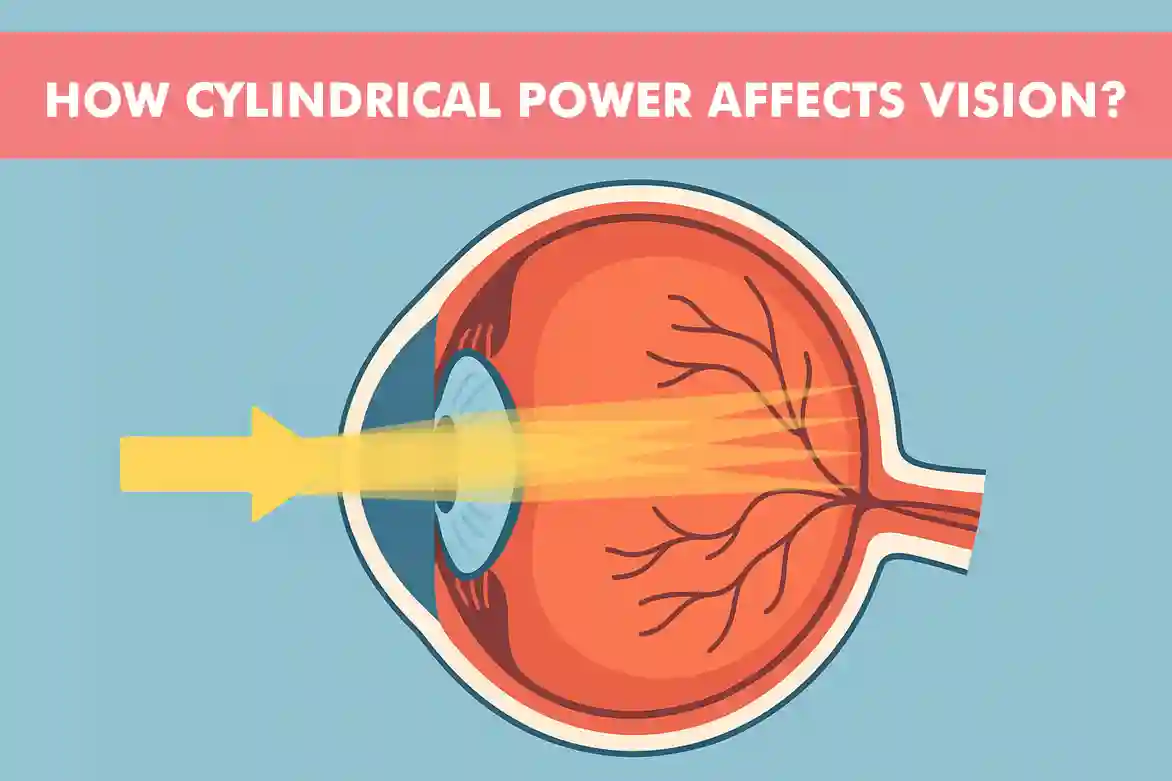Cylindrical power causes blurred or distorted vision due to an irregular curvature of the cornea or lens. This condition affects how light is focused on the retina, leading to visual discomfort and challenges in daily activities. Understanding what causes cylindrical power in the eyes and how to manage it is essential for maintaining optimal vision.
For people with normal vision, the cornea is round and evenly shaped, allowing light to focus at a single point on the retina. However, in individuals with cylindrical power, the cornea or lens is shaped more like a football rather than a perfect sphere. This irregularity causes light to focus on multiple points instead of one, leading to visual distortions. Recognising cylindrical power in eye symptoms and seeking the right treatment can help improve vision and reduce eye strain.
What Causes Cylindrical Power in Eyes?
Cylindrical power causes occur due to an uneven curvature of the cornea or lens, leading to improper light refraction. Several factors contribute to the development of this condition:
- Genetics: If one or both parents have astigmatism, there is a higher likelihood of inheriting cylindrical power. The shape of the cornea is largely determined by genetics, making astigmatism a common hereditary condition.
- Eye Injuries: Trauma to the eye can alter the shape of the cornea, leading to astigmatism. Physical injuries, accidental pokes, or post-surgical complications can induce changes in corneal curvature.
- Keratoconus: A progressive eye condition where the cornea thins and bulges into a cone-like shape, increasing cylindrical power. This condition worsens over time and can lead to severe astigmatism if left untreated.
- Post-Surgical Changes: Some eye surgeries, such as cataract removal or LASIK, can induce cylindrical power if the cornea heals unevenly. This may require additional corrective measures such as toric lenses or further surgical procedures.
- Prolonged Eye Strain: Extended screen time, poor lighting, and excessive near work may contribute to minor refractive changes over time. While eye strain alone does not cause astigmatism, it can worsen symptoms and increase discomfort.
Symptoms of Cylindrical Power
Individuals with cylindrical power often experience various symptoms that affect their daily activities. These symptoms can vary depending on the severity of the condition.
- Blurred or Distorted Vision: Objects may appear stretched or unclear at both near and far distances. Unlike typical nearsightedness or farsightedness, astigmatism causes images to appear wavy or skewed.
- Eye Strain and Discomfort: Frequent squinting or straining to see clearly can cause headaches and fatigue, especially after prolonged reading or screen use.
- Difficulty Seeing at Night: Low-light conditions may worsen visual distortion and glare sensitivity. Halos around lights, excessive reflections, and poor contrast sensitivity can make driving at night challenging.
- Frequent Changes in Prescription: Some individuals notice fluctuations in their vision correction needs. This may be an indication that the cylindrical power is increasing or that an underlying condition like keratoconus is developing.
- Double Vision (Diplopia): In severe cases, overlapping images may occur due to improper light refraction, making it difficult to focus on objects.
How to Reduce Cylindrical Power?
If you are wondering how to reduce cylindrical power, there are several ways to manage it effectively. While it may not always be possible to eliminate cylindrical power completely, these steps can help stabilise and improve vision:
- Regular Eye Check-Ups: Early detection allows for appropriate corrective measures, ensuring that vision remains stable.
- Proper Eyewear: Wearing cylindrical power glasses or contact lenses can help correct vision distortion and provide clearer eyesight.
- Lifestyle Changes: Reducing screen time, practicing eye exercises, and taking breaks during near work may prevent excessive strain, although they do not directly cure cylindrical power.
- Surgical Interventions: Procedures like LASIK, PRK, or toric intraocular lenses can provide permanent correction in certain cases, especially when cylindrical power is severe or progressing.
Cylindrical Eye Power Treatment
When considering cylindrical eye power treatment, there are several options available depending on the severity and lifestyle preferences of the individual.
Eyeglasses
Most people with cylindrical power use prescription glasses with toric lenses, designed to correct astigmatism by compensating for the uneven corneal curvature. Glasses are the most convenient and non-invasive way to manage cylindrical power.
Contact Lenses
Toric contact lenses provide an alternative to glasses and offer a wider field of vision. They are available in soft and rigid gas-permeable options. Unlike standard spherical lenses, toric lenses have different focusing powers at different orientations to correct astigmatism more effectively.
Refractive Surgery
Surgical options like LASIK and PRK reshape the cornea to eliminate astigmatism permanently, reducing or eliminating the need for glasses. These procedures are usually recommended for individuals with stable vision and no underlying eye diseases.
Is Cylindrical Power Harmful?
A common concern among individuals with astigmatism is, is cylindrical power harmful? Mild cylindrical power is generally harmless but may cause discomfort if left uncorrected. In severe cases, it can lead to visual disturbances affecting daily activities such as reading, driving, and using digital devices. Regular eye exams ensure that any worsening condition is managed appropriately.
Can Cylindrical Power Be Corrected?
Many people ask, can cylindrical power be corrected? Yes, cylindrical power can be corrected through prescription eyewear, contact lenses, or surgical interventions. The choice of correction depends on factors such as age, severity of astigmatism, and lifestyle requirements. Some cases may require ongoing prescription adjustments, while others can be permanently corrected through refractive surgery.
FAQs
Yes, cylindrical power can increase due to age, eye strain, or progressive corneal conditions. Regular eye check-ups help monitor changes and adjust corrective measures accordingly.
Eye exercises can help reduce strain but cannot cure cylindrical power, as structural changes in the eye cause it.
Depending on individual needs, prescription glasses, toric contact lenses, and refractive surgery are the most effective ways to correct cylindrical power.
Yes, spherical power affects overall nearsightedness or farsightedness, while cylindrical power specifically corrects astigmatism caused by irregular corneal shape.
In many cases, LASIK surgery can successfully correct cylindrical power, but suitability depends on individual eye health and corneal thickness.

